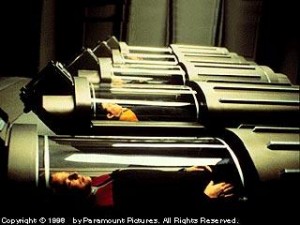 Everyone knows what it’s like: you eat your weight in turkey, go to sleep Thursday night, fall into a Tryptophan-induced coma, and wake up bleary-eyed, thinking that it must be days later because somehow, even though you swore you’d never eat again, you’re starving.
Everyone knows what it’s like: you eat your weight in turkey, go to sleep Thursday night, fall into a Tryptophan-induced coma, and wake up bleary-eyed, thinking that it must be days later because somehow, even though you swore you’d never eat again, you’re starving.
It’s not such a crazy idea, really.
Neither is hibernating through a day, week, or winter cold enough to freeze your eyeballs.
Suspended animation is no longer just for bears, or for science fiction. We may be on our way to taking an Ellen Ripley-esque snooze and waking up in space, ready to battle snarling, drooling aliens, or to inventing a substance like Somec, Orson Scott Card’s imagined hibernation serum used to prolong life by decades, even centuries.
Scientists at the University of Alaska Fairbanks–a great place to test out the possibilities of human hibernation–have figured out a way to stimulate torpor, which involves slowing down metabolism and oxygen consumption, and lowering body temperature without causing brain damage. These scientists use a substance that stimulates adenosine receptors in the brains of squirrels, which slows nerve cell activity and causes drowsiness. Scientists induced hibernation, or torpor, by injecting arctic squirrels with a substance that triggers adenosine receptors; they were also able to reverse torpor using a caffeine-like substance.
They don’t yet know if, or how much, the season affects the sensitivity of adenosine receptors, but they’ll run the experiments again using rats, which, strangely–or perhaps not so strangely–have a physiology that more closely resembles that of humans.
Another approach is to drastically lower metabolism by decreasing the body’s need for oxygen with a substance that binds oxygen receptors. Scientists at the Fred Hutchinson Cancer Research Center in Seattle have induced 24-hour suspended animation in yeast, worms, fruit flies, frogs, and fish.
Other researchers are trying different methods of inducing hibernation, such as injecting a mix of salt and ice that cools the body down to approximately 50 degrees Fahrenheit and causes hypothermia. The idea gained steam a few years ago after a Japanese man was found in a coma 24 days after disappearing on a snowy mountain; it’s thought that his state of frozen hibernation allowed him to recover fully.
So far, scientists have been able to induce suspended animation in pigs for several hours without any negative effects, and they’re confident that in the near future, induced hibernation could last for days, weeks, and months, as long as the subjects are fed intravenously.
Inducing torpor in humans could give doctors precious time needed to save patients in cardiac arrest or suffering from gunshot wounds without causing brain damage. Right now, scientists think that surgeons could operate on patients in suspended animation, whose hearts are not beating, for 60-90 minutes.
The FDA recently approved a technique pioneered by the chief of Tucson Arizona’s Trauma Center for conducting human trials on suspended animation. Depending on funding, the trials could begin in the next year.
Sign up and you might awake en route to Mars. Or maybe, just in time for next Thanksgiving. But if you hear any mention of carbonite, run.

2 Responses to Take That, Tryptophan